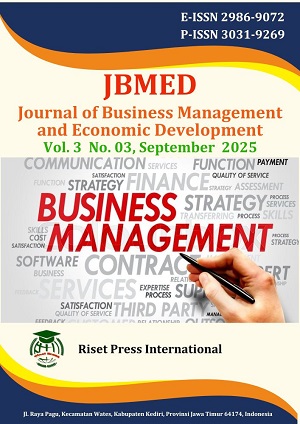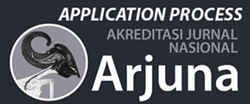Allocation of Input Use in Dryland Chili Farming of Kelompok Tani Hutan Panderman, Batu City
DOI:
https://doi.org/10.59653/jbmed.v3i03.1869Keywords:
Allocative Efficiency, Chili Cultivation, Dry Land, Economic Efficiency, Technical EfficiencyAbstract
Chili cultivation in dryland areas faces significant challenges, including limited water availability, low soil fertility, and the risk of land degradation. Under such conditions, the efficient use of inputs becomes a critical factor in enhancing both productivity and the sustainability of farming practices. This study aims to examine the influence of production factors on chili yield and to assess the levels of technical, allocative, and economic efficiency among chili farmers in Kelompok Tani Hutan Panderman. A quantitative approach with a descriptive-analytical method was employed. Primary data were gathered through questionnaires administered to 32 farmers selected via a census method and analyzed using multiple linear regression within a Cobb-Douglas production function framework. The results indicate that land area, labor, and farming experience have a significant positive impact on production, whereas excessive use of urea fertilizer and pesticides exerts a negative effect. While technical efficiency was largely achieved, allocative and economic efficiencies remain suboptimal. These findings highlight the importance of optimizing input allocation, adopting water-saving technologies, and implementing balanced fertilization strategies. The study’s implications point toward strengthening agricultural extension services, promoting appropriate technology adoption, and enhancing farmers’ managerial capacities to achieve sustainable productivity and efficiency.
Downloads
References
Ahmed, Y. N., Negm, M. M., Alnafissa, M., & Hefnawy, F. (2024). An empirical analysis of irrigation modernization projects using the CGE model. Environment, Development and Sustainability, 26(1). https://doi.org/10.1007/s10668-022-02754-0
Alizadeh, K., Gathala, M. K., Mohammadi, R., & Amri, A. (2023). Editorial: Dryland agriculture: crop adaptations, increasing yield and soil fertility. In Frontiers in Environmental Science (Vol. 11). https://doi.org/10.3389/fenvs.2023.1293440
Azhari, Muslinawati, R., Sakti, T. M. A., & Izah, W. R. (2025). Pengaruh Pengetahuan dan Inovasi Teknologi Terhadap Keberhasilan Usaha Tani. DIMENSI, 14(1), 238–251. https://doi.org/https://doi.org/10.33373/dms.v14i1.7409
Azwina, R., & Syahbudi, M. (2022). Pengaruh Fluktuasi Harga Komoditas Pangan Terhadap Inflasi di Provinsi Sumatera Utara tahun (2019-2021). El-Mal: Jurnal Kajian Ekonomi & Bisnis Islam, 4(1). https://doi.org/10.47467/elmal.v4i1.1373
Gaviglio, A., Filippini, R., Madau, F. A., Marescotti, M. E., & Demartini, E. (2021). Technical efficiency and productivity of farms: a periurban case study analysis. Agricultural and Food Economics, 9(1). https://doi.org/10.1186/s40100-021-00181-9
Gitaningtyas, O. P. (2022). The Impact Of Certified Seeds Adoption On Cost Efficiency Of Horticultural Cultivation. Journal of International Conference Proceedings. https://doi.org/10.32535/jicp.v5i4.1897
Khomsah, K., Kamilah, I., Alfen, T. Z. S., Suryawati, G., & Zaifah, K. F. (2022). Analisis Efisiensi Teknis Dan Ekonomis Penggunaan Faktor-Faktor Usahatani Padi Di Desa Burneh, Kecamatan Burneh, Kabupaten Bangkalan. Agricore: Jurnal Agribisnis Dan Sosial Ekonomi Pertanian Unpad, 7(1). https://doi.org/10.24198/agricore.v7i1.40375
Liang, X. (2023). Research on the Influence of the Law of Diminishing Marginal Returns in Agriculture. Advances in Economics, Management and Political Sciences, 8(1). https://doi.org/10.54254/2754-1169/8/20230323
Nakachew, K., Yigermal, H., Assefa, F., Gelaye, Y., & Ali, S. (2024). Review on enhancing the efficiency of fertilizer utilization: Strategies for optimal nutrient management. Open Agriculture, 9(1), 1–15. https://doi.org/10.1515/opag-2022-0356
Nurul C, V., Muslich Mustadjab, M., & Fahriyah, F. (2018). Analisis Efisiensi Alokatif Penggunaan Faktor-Faktor Produksi Pada Usahatani Padi (Oryza Sativa L.) (Studi Kasus Di Desa Puhjarak, Kecamatan Plemahan, Kabupaten Kediri). Jurnal Ekonomi Pertanian Dan Agribisnis, 2(1). https://doi.org/10.21776/ub.jepa.2018.002.01.2
Okello, D. M., Bonabana-Wabbi, J., & Mugonola, B. (2019). Farm level allocative efficiency of rice production in Gulu and Amuru districts, Northern Uganda. Agricultural and Food Economics, 7(1). https://doi.org/10.1186/s40100-019-0140-x
Othuon, V., & Oyugi, M. (2023). Technical Efficiency of Fertilizer Adoption and Smallholder Maize Productivity in Kenya. Stochastic Frontier Analysis. Journal of Economics and Sustainable Development, 14(17), 82–106. https://doi.org/10.7176/jesd/14-17-08
Penuelas, J., Coello, F., & Sardans, J. (2023). A better use of fertilizers is needed for global food security and environmental sustainability. In Agriculture and Food Security (Vol. 12, Issue 1). https://doi.org/10.1186/s40066-023-00409-5
Radlińska, K. (2023). Some Theoretical and Practical Aspects of Technical Efficiency—The Example of European Union Agriculture. Sustainability (Switzerland), 15(18). https://doi.org/10.3390/su151813509
Rejekiningrum, P., Apriyana, Y., Sutardi, Estiningtyas, W., Sosiawan, H., Susilawati, H. L., Hervani, A., & Alifia, A. D. (2022). Optimising Water Management in Drylands to Increase Crop Productivity and Anticipate Climate Change in Indonesia. In Sustainability (Switzerland) (Vol. 14, Issue 18). https://doi.org/10.3390/su141811672
Royun Nuha, M., Andita Putri, T., & Dwi Utami, A. (2023). Pendapatan Usahatani Cabai Merah Berdasarkan Musim di Provinsi Jawa Tengah. Jurnal Ilmu Pertanian Indonesia, 28(2). https://doi.org/10.18343/jipi.28.2.323
Sharma, I., & Sekhon, M. K. (2021). Measurement and Determinants of Technical Efficiency in Crop Production: A Review. Agricultural Reviews, Of. https://doi.org/10.18805/ag.r-2144
Stringer, L. C., Fraser, E. D. G., Harris, D., Lyon, C., Pereira, L., Ward, C. F. M., & Simelton, E. (2020). Adaptation and Development Pathways For Different Types of Farmers. Environmental Science and Policy, 104. https://doi.org/10.1016/j.envsci.2019.10.007
Wati, M., Djohar, N., & Diah, D. (2020). Efisiensi Penggunaan Input Usahatani Cabai Merah Besar (Capsicum Annum L.). Oryza: Jurnal Agribisnis Dan Pertanian Berkelanjutan, 5(1), 6–14. https://doi.org/https://doi.org/10.56071/oryza.v5i2.725
Yakup, Y., Simamora, W. K. S., Jenyca, Z. A., Sholehah, N., Hunafa, G. Z., & Laoli, J. (2024). Efikasi Pupuk Organik dan Pupuk Anorganik terhadap Pertumbuhan dan Produksi Tanaman Padi di Lahan Kering. Prosiding Seminar Nasional Lahan Suboptimal Ke-12 Tahun 2024, 6051, 461–476.
Yoga, T., Saputro, A. J., & Anggriani, Y. (2024). Improving Rice Farming Efficiency: Insights from Stochastic Frontier Analysis in Ponorogo District. Buletin Penelitian Sosial Ekonomi Pertanian Fakultas Pertanian Universitas Haluoleo, 26(2), 124–131. https://doi.org/10.37149/bpsosek.v26i2.1372
Downloads
Published
How to Cite
Issue
Section
License
Copyright (c) 2025 Fridolin Triayen Palus, Agnes Quartina Pudjiastuti, Tirta Yoga

This work is licensed under a Creative Commons Attribution-ShareAlike 4.0 International License.
Authors who publish with this journal agree to the following terms:
- Authors retain copyright and grant the journal right of first publication with the work simultaneously licensed under a Creative Commons Attribution-ShareAlike that allows others to share the work with an acknowledgement of the work's authorship and initial publication in this journal.
- Authors are able to enter into separate, additional contractual arrangements for the non-exclusive distribution of the journal's published version of the work (e.g., post it to an institutional repository or publish it in a book), with an acknowledgement of its initial publication in this journal.
- Authors are permitted and encouraged to post their work online (e.g., in institutional repositories or on their website) prior to and during the submission process, as it can lead to productive exchanges, as well as earlier and greater citation of published work (See The Effect of Open Access).





























